Knowing what kind of equipment to salvage for electronic components isn’t enough; you have to know how to get the parts out, or you’re just stockpiling junk. Through-hole ICs may be best stored on the original circuit boards to salvage when needed; but common components like resistors, capacitors, and diodes are much more economical to salvage in bulk, then sort, store, and have ready on demand.
I desolder with a heat gun and pull the components out with pliers. I destroy a few components on nearly every board I salvage; but it’s incredibly fast compared to any other method I’ve tried. For me, the time savings I discovered when I switched to using a heat gun was what made it really worthwhile to salvage components in bulk and stock up my parts bins.
Here’s a circuit board that one of the electricians at work brought me. I don’t know what it does; but he works a lot with the elevators and it’s probably something out of an elevator control system.
It’s not representative of the resistor- and capacitor-laden boards I particularly advocate salvaging; but I had it on hand and it does serve to demonstrate my method.
Uncrimping Component Leads
Through-hole components on commercially-produced boards tend to have their pins crimped on the solder side, to hold the components in place during the time between stuffing and soldering. Even with the solder melted, you can’t pull out a crimped component with pliers, so the first step is uncrimping the leads.
I use an cheap 1/4″-tip wood chisel from a dump bin at my local Ace Hardware store. (This is “my best $3 chisel” that I’ve referred to before — my real wood chisels never come anywhere near metal.) It doesn’t need to be sharp, but the edge should be fairly straight. I use a similarly cheap diamond honing board to clean up the nicked edge from time to time.
I push the chisel into the solder under the lead and lever up to straighten it. It’s important to get the chisel edge all the way to where the lead comes out of the hole, or you won’t be straightening the lead; you’ll be putting another zig in its zag.
Keep your other hand out of the path of the chisel. I’ve slipped the chisel off of leads, cut leads clean off, and tried to pry up solder pools that didn’t have leads in them. All of these result in a narrow, sharp object moving forward at high speed with a fair bit of pressure behind it. Again, think about where the chisel is going to go when it slips and keep your fingers out of the way.
It took only a couple of minutes to uncrimp the few leads on this board. Larger boards may take five to ten minutes; CRT motherboards can take half an hour, and I tend to do them in sections because uncrimping leads is really tedious and boring.
Heating and Removing Components
Once the leads are uncrimped, I clamp an edge of the board into my bench vise and get ready to heat it up. You need a bench vise that’s heavy or bolted down — you’re going to be prying and wiggling on the components quite a bit to get them out.
Now is a good time to remove fuses from holders, and optionally remove any socketed components from their sockets as well.
I use a cheap heat gun that I got for $15 at Harbor Freight. I regard it as a disposable item — I go through one in about a year (during which time I’ve salvaged far more than $15 of components) and go buy another.
Starting at the bottom edge of the board, I heat the solder side with the gun 1-2″ away until the solder melts, then pull out the components with a needlenose pliers and drop them in a cup. It’s faster and easier for me to put them in a container and sort them later than to place them carefully on my workbench and have them get brushed around, but your mileage may vary.
Some notes about the actual desoldering and component removal process:
- The first component is going to take a long time to heat up. Be patient; pulling before the solder is fully melted will just break the part.
- You can see the solder melt. Watch for it.
- Start at the bottom and work up a column, angling the heat gun in the direction you want to go. It’ll start melting the next component’s solder while you’re removing the previous one. You can go quite fast on a stack of properly uncrimped resistors.
- Get out the regular pliers for larger items, and particularly for DIP components. Rock them back and forth very gently until you can see that all the pins are loose, then slip them free.
- Don’t hang onto a resistor lead with the pliers while you’re heating it — you’re just making a heatsink and preventing the solder from melting. Heat the solder, then grab quickly with the pliers and pull. You may get both leads in one pull; or you may get one end loose, readjust your grip, and get the other end.
- TO-220 parts may fit tightly enough that they don’t want to come loose even after the solder melts. This can mean pulling the plating out of the through-holes, which then means cleaning the tubes off the leads later. A giant 3/8″ chisel-tip soldering iron laid across all three leads will pop a TO-220 free in an instant.
- PC boards are flexible, especially when hot. Long strip connectors may require freeing one end and bending both connector and board as you work along the connector to free the remaining pins.
- Larger heatsinks (PC power supplies and CRT motherboards) may have tabs that need to be untwisted, and their tabs or posts may fit tightly through barely large enough holes in the circuit board. If necessary, save them for last and force them out with large pliers.
This sounds obvious, but when you’re done desoldering, the circuit board is still hot. I hold it with pliers while loosening the vise, then lay it on the concrete floor to suck the heat out.
Make no mistake, this is a destructive process. The circuit board will be ruined, and the fumes from scorched fiberglass are probably not good for your health nor for your relationship with your significant other or housemates. It’s best to do this as close to the outdoors as you can get and with windows open and forced air ventilation, if you have the option.
Finally, recycle the board if you can. We have a very thorough curbside recycling program here, and I’ve set out a large box of stripped circuit boards (with an appropriate note) for copper reclamation.
Sorting the Spoils
Here’s the cup into which I dropped the parts as I was pulling them:
And the parts sorted on my workbench:
I got a couple of terminal strips, several DIP sockets (one irreparably damaged), four TTL ICs and two resistor packs, eight NPN transistors, diodes, LEDs, one capacitor, and fuses and fuse holders. Not great, but not bad for fifteen minutes’ work.
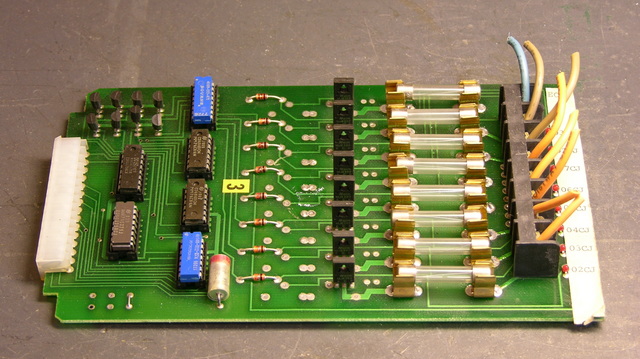
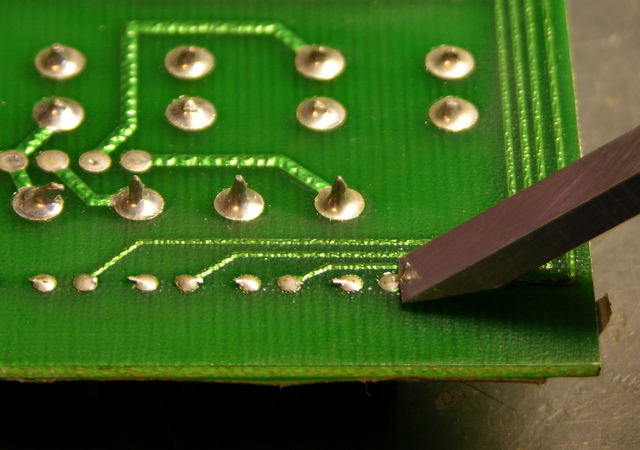
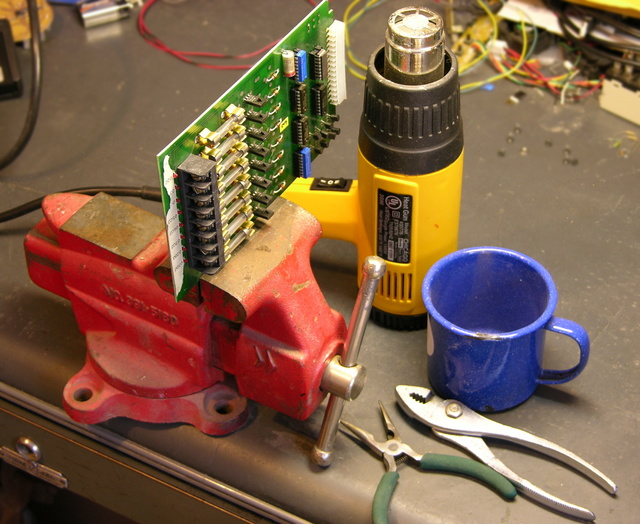
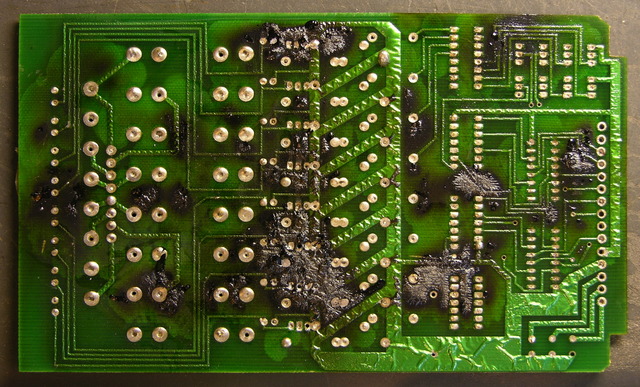
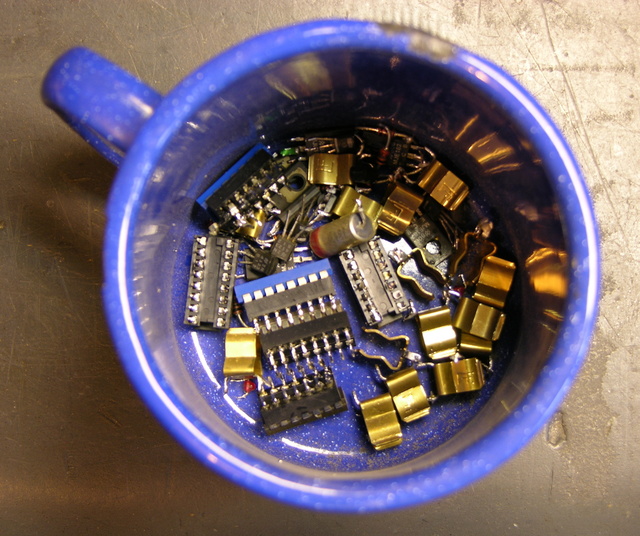
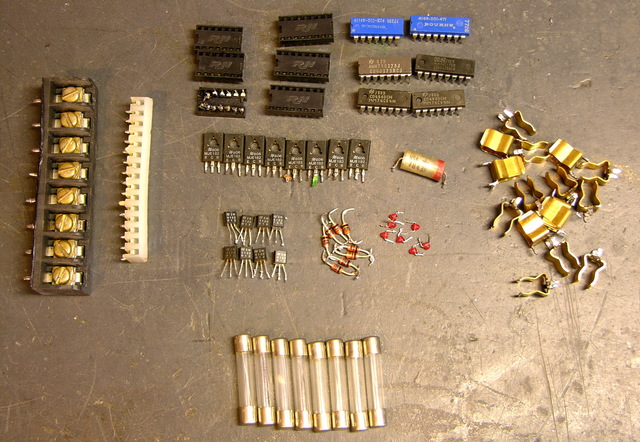
I have found that a blow torch works pretty good, and doesnt take as long as the heat gun. Just make sure you don’t overheat!
Eric, I’ve tried a torch and got a lot more noxious fumes. I also wasn’t comfortable doing the blowtorch with one hand and the pliers with the other — if the heat gun slips around the edge of the board, your plucking hand just gets pretty hot, instead of charred. But whatever works for you is cool.
I understand. I actually don’t hold the torch….I have a device I use for heating aluminum arrows to put the inserts in, and it uses that (works well to, since the nozzle on torch is small, and the flame is low. The garage door is always open when I do these things too, with the fans extracting the fumes.
Brilliant! I’ve been using a soldering iron alone for removing parts – takes forever. Never thought to use the heat gun. I too got a cheapie Heat Gun – ‘official’ heat shrink guns cost $40 or so, but I found a plain old paint-remover type heat gun at BigLots! for about $12 or so. I use the low setting for heat-shrink; guess I’ll try high for parts scavenging.
Keith, to who do I sell these parts to after I get a bunch stockpiled?
Dave, you are what I believe is referred to as an optimist.
Dave, the eternal optomist and all concerned. Save the time desoldering…. I will purchase LARGE quantities of boards before you go to the troulbe.
Or, if you want to purchase boards TO desolder I will sell them to you… lot of great stuff on them you might can use.
regards
Any advice on salvaging old cell phone components such as the LCD screen and camera? Seems like a goldmine of goddies if possible.
Willie, here’s a link to hacking Nokia cell phone displays:
http://www.selbing.com/_jakob/electronics/nokia.htm
I haven’t done anything with LCD screens outside of that. However, there’s always stuff going on with cell displays at Spark Fun Electronics. Maybe their site will give you some ideas?
Have you tried any of the “attachments” for the heat gun? There’s one that looks like it concentrates the air on a smaller area. I was wondering if this would melt the solder faster.
My heat gun (looks just like yours) takes a long time to get the board hot enough to melt the solder. I’m looking for ways to speed up the process.
ckiick, nope, I haven’t tried any attachments. I actually find that the heat from my gun is about as focused as I want it to be — it gives me a slight headstart on the next piece I’m going to pull, but doesn’t melt a large area. In fact, I wish I had broader coverage when I’m desoldering 40-pin IC sockets and large edge connectors.
The little nozzle thing might be handy if you just want to remove one component quickly, though. And maybe it’d make removing individual components so much faster, it’d be a net win over what I have now.
If you try one, please come back and say how it worked!
Bought a heat gun this week, and tried it out last night.
I have a bunch of boards with seven-segment LEDs on them. I clamped the board in my vise, grabbed the 7-seg part with a chip puller, and then applied gentle rocking tension on the part while holding the heat gun over the pins on the back side of the board. Note that the pins weren’t bent in any way, so it should slide straight out when the solder becomes molten.
The heat gun I have is adjustable, and the upper range is in the four digits (F), so I started with the dial set mid-way. After having no luck, I let the board and part cool, cranked up the heat somewhat, and tried again. I did this until the heat gun was on maximum.
I finally got the part out after too much time and too much applied tension. I noticed later that one of the pins had separated from the chip (presumably due to heat), but was still soldered into the board.
I’ll keep trying, but it was pretty disappointing. It seems as though the board is sinking away too much heat, or the solder they used was different somehow–like a higher melting point. I’m really having to cook things to get the part loose at all…
INTJ, I damage the most parts when I’m impatient and pulling too hard too early — it really takes a while to get things heated up. But I usually heat for a long time and rock extremely gently just so I know they’re loose, then pull only when they’re so loose they’re about to fall out on their own. It sounds like you were doing much the same thing.
I’ve salvaged a few boards where the drill holes were so small, the pins physically fit through very tightly regardless of solder. Maybe that’s what happened here?
Any chance you could email me some close-up pics of one or two of those boards, maybe before and after? Don’t know whether I can really do remote diagnosis, but it might ring a bell with something I’ve encountered before.
OK, I tried again tonight, and had much better luck. I was able to remove a bunch of the 7-segment LEDs with no apparent damage (pending testing).
It takes longer than I thought it would, and it seems like bigger blobs of solder are resistant to head-gun heat, even when other pins are completely molten. Components with larger pins (e.g. TO-220) refuse to come out this way. I can pull forever – eventually I can see the board around the pins getting soft, but the solder isn’t molten because the leads are just wicking away too much heat.
In one case, I was removing a 5-pin component that stubbornly refused to let go of one pin (with more solder than the others). I had my soldering iron on, and without removing the heat gun, I picked up the iron with my free hand and touched the pin. The part immediately came loose.
This led me to wonder about a hybrid approach: using the heat gun to sustain heat, and using the soldering iron on each pin. I’m going to give this a try and see if it’s significantly better.
INTJ, glad it worked better when you retried.
I don’t have any trouble heating larger solder blobs with my heat gun. One thing I do notice, though, is that the heat delivery pattern of my heat gun is not as obvious as I’d think, and it often helps to wave the gun around a little (even just 1/2″ side to side).
I can often get TO-220s with the heat gun, and often can’t. My assessment is that it has to do with the size of the through-holes more than the amount of solder — with bigger holes, the solder melts and the parts fall right out. Toward the bottom of a much older post, I relate my tremendous success using an iron with a .3″ chisel tip to get TO-220s. Didn’t need the heat gun at all.
Good advice thanks. Chisel is my fave tool for breaking up the board to start with as well as to bend leads straight enough to desolder things.
I will have to get a really powerfull heat gun before my next salvage project.
I can’t believe how much time I put in trying to desolder with an iron, a sucker and some wick. This method is 50 times faster at least. I like when the board shakes, some solder flies, and several components just fly off the board.
Good ventilation is a must. We work on these in a wood shop, with the big vents running. We also have a fan blowing at the board from behind the person, so the fumes are pushed away to begin with.
This is quality. I’ve been salvaging anything I can from printers/scanners. I am mostly after the stepper motors (or as I have learnt, standard DC motors with Optical Encoders + wheels). Old AFGA scanners if anyone is looking for decent stepper motors – is it worth me documenting the build quality/components etc from my endless supply of printers and scanners?
Anyway, the heat gun thing I shall be trying this evening. Thanks for sharing. I wanted to chip in and mention something when desoldering with an iron. I noticed on some of the HP boards, that holed components had a square and a circle on a resistor. One would heat up fairly quickly, the other would take a LONG time. Are manufacturers mixing solder types to make it harder to salvage/recycle the boards?
Anyone who would like to share (recycle) parts is also encouraged to check out The Great Internet Migratory Box ‘O Electronics Junk or TIMBOEJ http://www.tgimboej.org . I have started 2 boxes of junk on migratory paths this year.
Anyone wanting to contact me, and send a box of junk my way, just google my name, yes, that’s me.
As far as solder on boards, I can only imagine a solder bath holds one kind of solder only, if it did not, there would be board failures one suspects. If some parts are harder to remove, it’s the hole size that is intentionally differing, or whether the hole is in fact thru-plated or not.
Folow up on my attempts with a heat gun. It works! Better than I expected.
So my tips based on the 20 boards I’ve stripped so far.
1. Heat up the face side of SMD components and scrape them off before working the other parts…they pop, and shoot off, sometimes inside the gun
2. Plastic parts, focus the heat on the underside, and remove plastic parts first, BEFORE the board gets too hot. – I used this to obtain some more optical encoders, lots of switches, and connectors.
3. If there is a particular IC that you are interested KEEP the board handy, or better still take a picture of the wiring BEFORE you break it down. That way, if you can’t fid a datasheet on the small LCD screen it drives, you can perhaps figure out what is going on using the original (HT1621D driving an unknown LCD in my case).
I now have a question. What do I do with this bag full of SMD IC’s that I have no use of? Conrad Braam, is it worth sticking these into TIMBOEJ box?
Hi tehgringe.
Agreed on the 3rd point. I take pictures of things before fiddling, now that digital cameras are good enough to see better with than me own eyes.
A tgimboej is probably not a great place for SMT components, but they are light, and the idea of the box is to give others a chance to get components they would not otherwise get. I would stick them in, with a label on the packet saying “un-tested”.
My rules for sticking something into a http://www.tgimboej.org box:
1. I would love to build this into something, but I’m honestly never going to get around to using it.
2. I dunno what it is, but it probably works.
3. I have lots of these, and cannot possibly use them all.
I will have to try get a heat gun
For years I have been using a soldering iron to heat the solder
then I use an air hose to blast off the solder. This works really
good. Just be sure to do it outside where there is no chance of
fire.